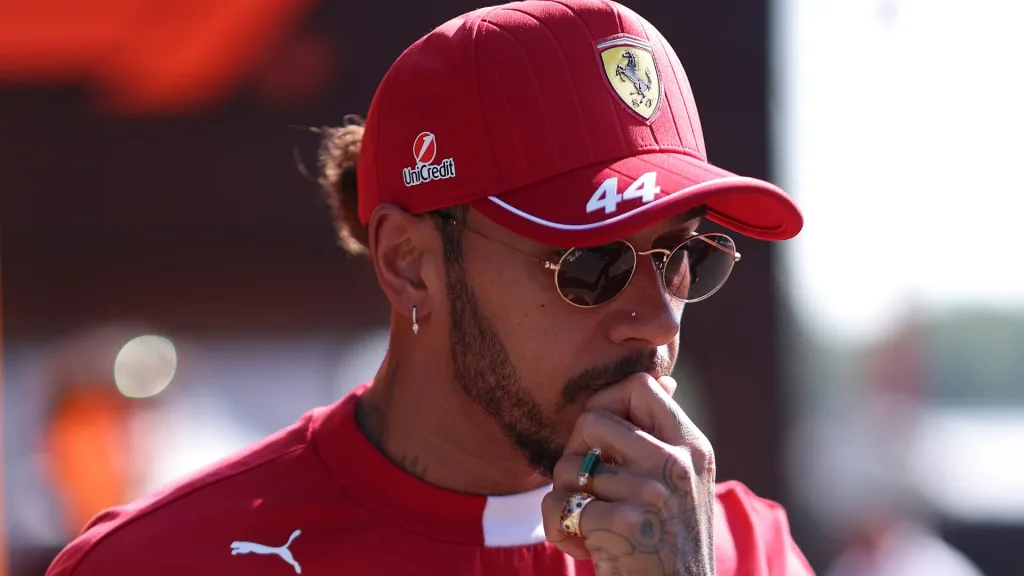Lewis Hamilton’s remarkable run of 11 consecutive podium finishes at the British Grand Prix came to an abrupt end on Sunday, as the seven-time World Champion finished fourth in a challenging race marked by variable weather conditions. The Ferrari driver openly admitted that his SF-25 was “the most difficult car I’ve ever driven” in the wet-dry conditions at Silverstone, highlighting ongoing struggles in his debut season with the Scuderia.
Hamilton, who started fifth on the grid, showed early promise by attacking race winner Lando Norris in the opening laps. However, a combination of strategic missteps and the car’s unpredictable handling in the rain saw him lose ground, ultimately finishing behind McLaren’s Norris and Oscar Piastri, and Sauber’s Nico Hulkenberg, who claimed his maiden F1 podium. “It was the most difficult car I’ve driven here in these conditions,” Hamilton told media after the race. “The car was unbelievably tricky to drive. I think, ultimately, I learned a lot today, but I can’t even express to you how hard it is.”
The race was a rollercoaster of changing conditions, with a damp track at the start giving way to heavier rain before drying out again. Hamilton’s Ferrari struggled particularly in the wet, with the 40-year-old describing it as “snappy” and lacking stability, especially in low-speed corners. “It just has no stability. You go to a corner, and it’s snapping, snapping, snapping. It just won’t stay still, and that makes it so difficult,” he explained to Sky Sports F1. “In the low speed, it doesn’t like to turn. It’s a really frustrating balance.”
Ferrari’s challenges were compounded by a GPS failure on Hamilton’s car, which left the team “completely blind” during the race, according to team principal Fred Vasseur. This issue hampered their ability to make informed strategy calls, notably when Hamilton pitted for slick tires a lap too early, losing crucial time after running wide at Turns 3 and 4. “You can say now that it was probably one lap too early because he lost four or five seconds in those two corners,” Vasseur admitted.
Despite the disappointment, Hamilton remained optimistic, viewing the race as a learning opportunity. “It’s only my second time driving this car in the wet,” he noted. “For me, it’s important to sit down with the people designing the car for next year because there’s elements of this car that cannot go into the following year.” He also took heart from the support of the Silverstone crowd, many of whom donned Ferrari red in a show of loyalty. “What I take from it is the amazing energy from all the fans,” he said. “They’ve been incredible this weekend, and it’s been amazing to see so many people switch to red.”
Hamilton’s teammate, Charles Leclerc, fared worse, finishing a dismal 14th after a costly decision to start on slick tires backfired, followed by a spin at Becketts. The Monegasque driver’s struggles underscored Ferrari’s difficulties with the SF-25 in changeable conditions, with Hamilton noting, “It’s not a car that likes those conditions.”
The race marked a missed opportunity for Ferrari, who had shown promising pace earlier in the weekend. Hamilton topped Friday’s opening practice and was in contention for pole during qualifying, only to lose time with understeer in the final corner. “I just had understeer at Turn 16,” he said after qualifying. “That lost me the time that I had.”
As Ferrari heads to the Belgian Grand Prix, Hamilton is focused on addressing the SF-25’s shortcomings. “We have no stability,” he stated. “The car just doesn’t stay settled. We wish it would be more stable, especially in the low-speed corners where it becomes very difficult to turn in.” With upgrades planned for upcoming races, Hamilton remains hopeful that lessons from Silverstone will pave the way for stronger performances. For now, though, the British Grand Prix served as a stark reminder of the challenges he faces in adapting to Ferrari’s temperamental machine.

